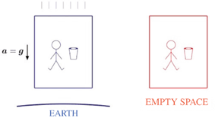Abstract
The continuum form of the Gauss-Hertz principle is extended to include the time domain as well as space. The Schrödinger equation and general relativity are derived by this method. The equivalence of the principle is shown to that of the Hamiltonian method where the energy is the expression −[φ∇2φ+A·∇2 A], with φ being the difference between the acceleration potential and potential energy density, andA being the difference between the vector potentials of the acceleration field and the force field. The goal of Hertz to “demonstrate a third arrangement of the principles of mechanics...which starts with... time, space and mass” has apparently been achieved for relativity and for quantum mechanics, in addition to those classical equations previously found.
Similar content being viewed by others
References
R. L. Moore,Found. Phys. 7, 129 (1977).
R. L. Moore, Hooke's law derived by minimization principles, TR Twentieth Conf. of Army Mathematicians, ARO Report 75-1 (1974), pp. 383–386.
R. L. Moore,Proc. IEE 123, 476 (1976).
R. L. Moore,Phys. Fl. 20, 1374 (1977).
R. L. Moore,Bull. Am. Phys. Soc. 20 1433 (1975).
W. Yourgrau and S. Mandelstam,Variational Principles in Dynamics and Quantum Theory, 3rd ed. (Pitman, London, 1968).
C. Lanczos,The Variational Principles of Mechanics (University of Toronto Press, Toronto, 1949), esp. Chapter IV, Section 8 and Chapter V.
E. G. Cullwick,Electromagnetism and Relativity, 2nd ed. (Longmans, Green and Co, London 1959).
H. B. Phillips,Vector Analysis (Wiley, New York, 1933).
S. Rosseland,The Pulsation Theory of Variable Stars (Oxford, 1949), Eq. (3.2).
R. L. Moore,J. Elect. and Control,14, 1 (1963).
R. L. Moore,Bull. Am. Phys. Soc. 6, 504 (1961).
J. P. Wesley,Phys. Rev. 122, 1932 (1961).
E. Whittaker,A History of the Theories of Aether and Electricity, Vol. II:The Modern Theories (Harper reprint, London, 1953), p. 195.
W. Heisenberg,Physics Today (March 1976).
C. Truesdell,Essays on the History of Mechanics (Springer-Verlag, New York, 1968), p. 187.
H. Hertz,The Principles of Mechanics (Dover, New York, 1956), p. 24.
C. Truesdell,The Kinematics of Vorticity (Bloomington, Indiana, 1954).
Author information
Authors and Affiliations
Rights and permissions
About this article
Cite this article
Moore, R.L. Further extension of the Gauss-Hertz principle. Found Phys 8, 359–370 (1978). https://doi.org/10.1007/BF00708568
Received:
Issue Date:
DOI: https://doi.org/10.1007/BF00708568




